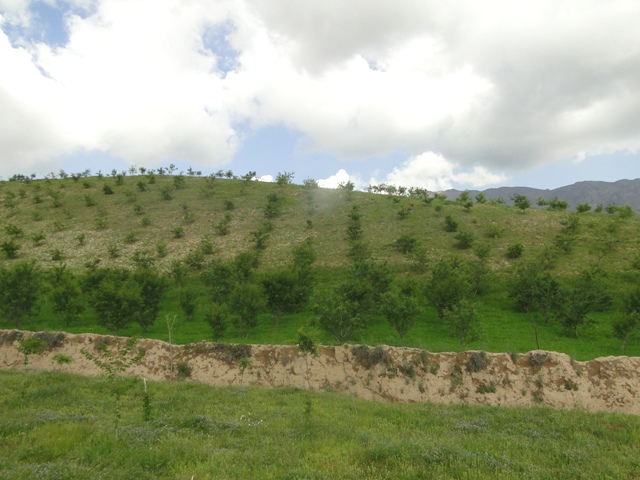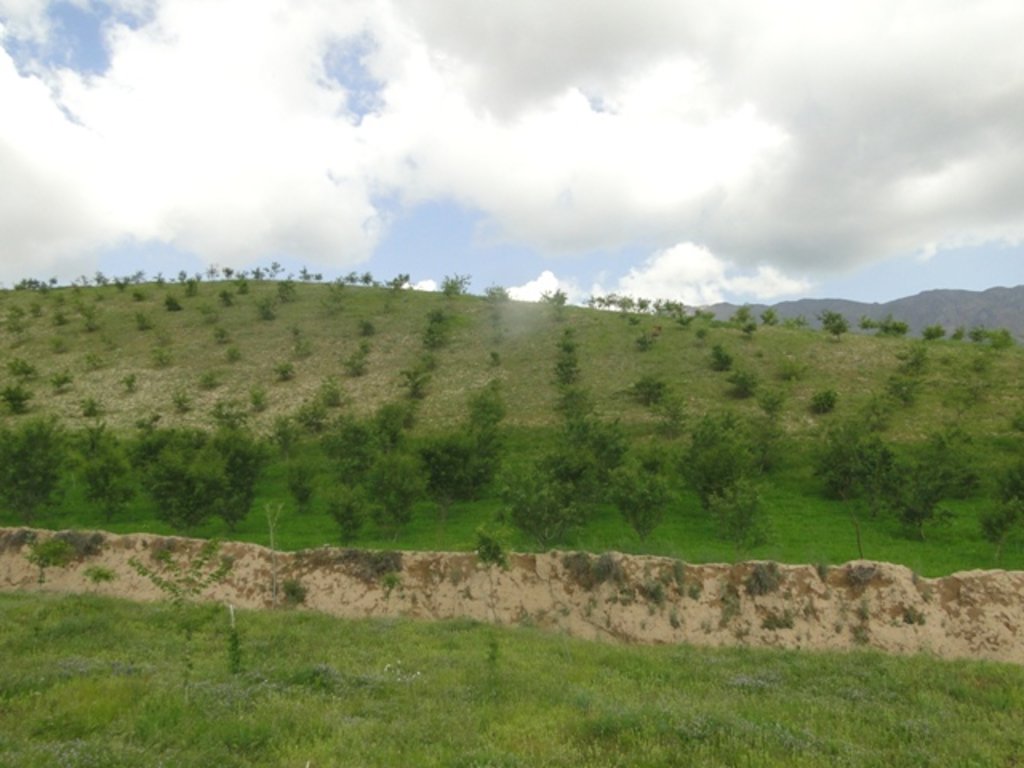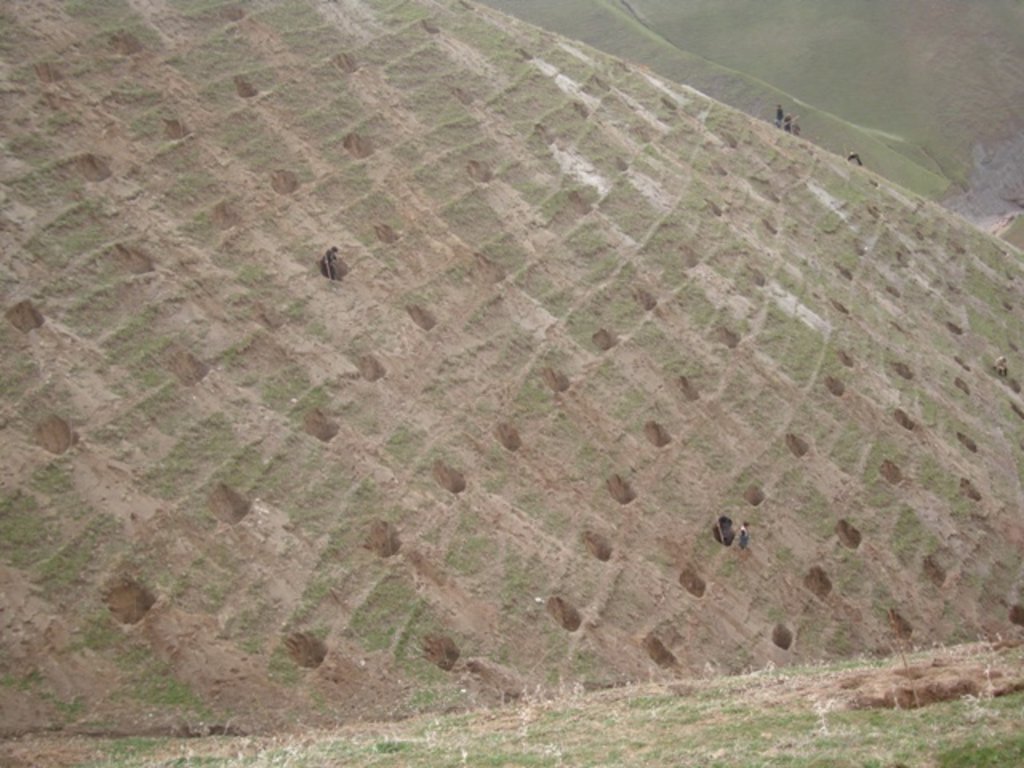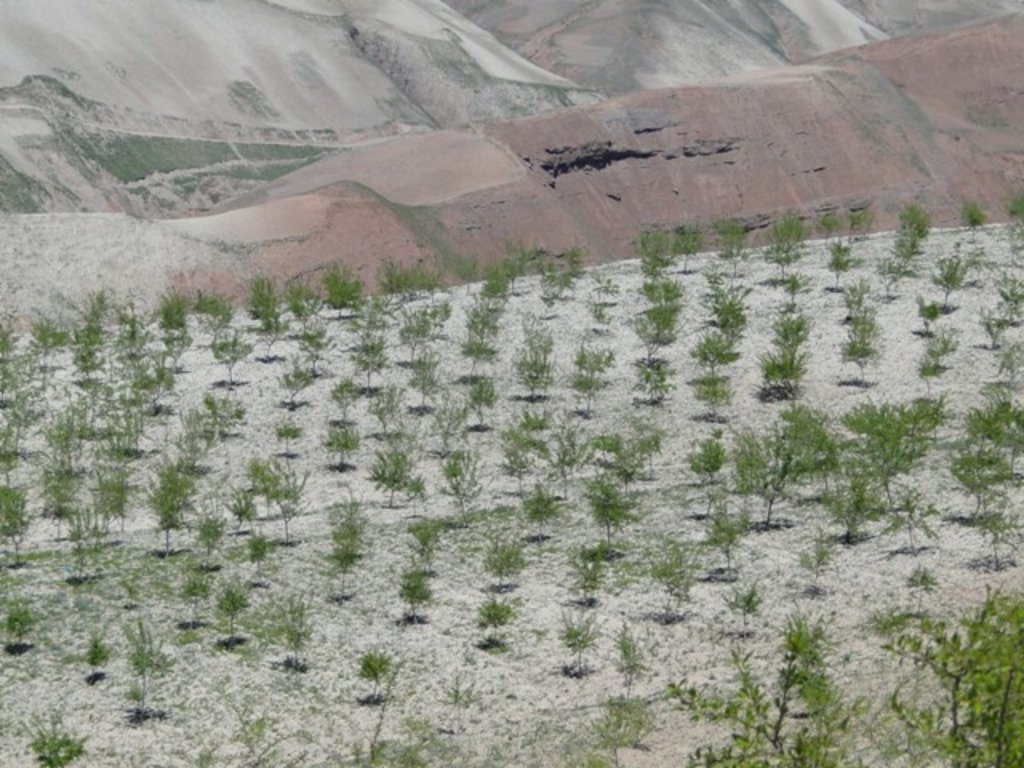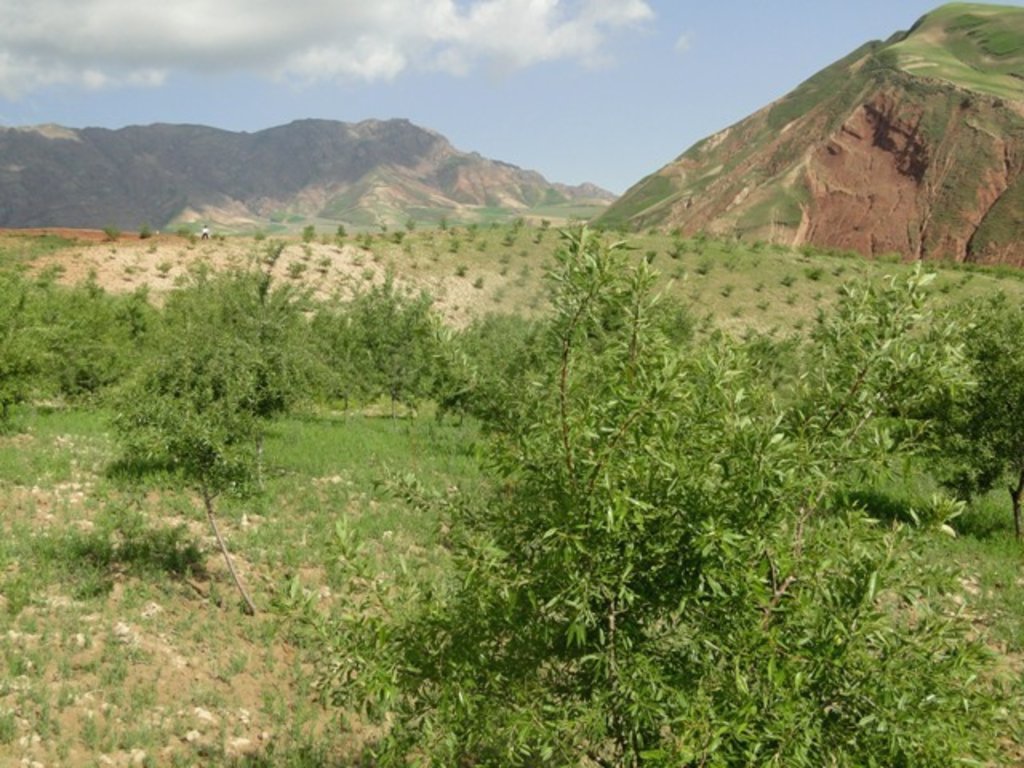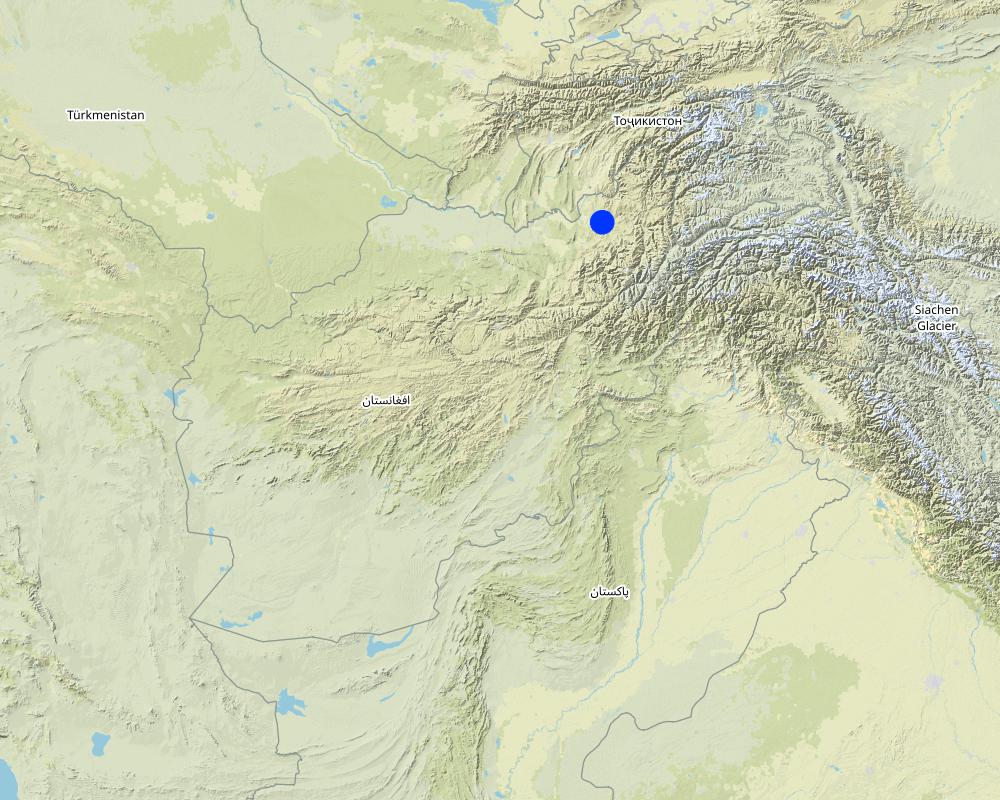Afforestation for firewood production [Afghanistan]
- Création :
- Mise à jour :
- Compilateur : Bettina Wolfgramm
- Rédacteurs : MIAJAN MAROOFI, Hekmatullah Sharifzai, Roziya Kirgizbekova, Aslam Qadamov, Aqila Haidery
- Examinateur : William Critchley
Bunyodi jangal baroi tavlidi chubi sukht
technologies_668 - Afghanistan
Voir les sections
Développer tout Réduire tout1. Informations générales
1.2 Coordonnées des personnes-ressources et des institutions impliquées dans l'évaluation et la documentation de la Technologie
Personne(s)-ressource(s) clé(s)
exploitant des terres:
Mohammad Azim Habibullah
Natural Resources Management Comittee (NRMC)
Sari Joy Village, Rustaq District
Afghanistan
Spécialiste GDT:
Spécialiste GDT:
Researcher:
Nom du projet qui a facilité la documentation/ l'évaluation de la Technologie (si pertinent)
Potential and limitations for improved natural resource management (NRM) in mountain communities in the Rustaq district, Afghanistan (Rustaq NRM Study)Nom du projet qui a facilité la documentation/ l'évaluation de la Technologie (si pertinent)
Livelihood Improvement Project Takhar, Afghanistan (LIPT)Nom du ou des institutions qui ont facilité la documentation/ l'évaluation de la Technologie (si pertinent)
Terre des Hommes (Terre des Hommes) - SuisseNom du ou des institutions qui ont facilité la documentation/ l'évaluation de la Technologie (si pertinent)
Swiss Agency for Development and Cooperation (DEZA / COSUDE / DDC / SDC) - SuisseNom du ou des institutions qui ont facilité la documentation/ l'évaluation de la Technologie (si pertinent)
CDE Centre for Development and Environment (CDE Centre for Development and Environment) - SuisseNom du ou des institutions qui ont facilité la documentation/ l'évaluation de la Technologie (si pertinent)
Bern University of Applied Sciences, School of Agricultural, Forest and Food Sciences (HAFL) - Suisse1.3 Conditions relatives à l'utilisation par WOCAT des données documentées
Quand les données ont-elles été compilées (sur le terrain)?
27/10/2016
Le compilateur et la(les) personne(s) ressource(s) acceptent les conditions relatives à l'utilisation par WOCAT des données documentées:
Oui
1.4 Déclaration sur la durabilité de la Technologie décrite
Est-ce que la Technologie décrite ici pose problème par rapport à la dégradation des terres, de telle sorte qu'elle ne peut pas être déclarée comme étant une technologie de gestion durable des terres?
Non
Commentaires:
SLM practices documented in the frame of the Rustaq NRM study were established only recently (1-3 years ago). It is too early for a final judgment on the sustainability of these technologies within the human and natural environment of Chokar watershed.
2. Description de la Technologie de GDT
2.1 Courte description de la Technologie
Définition de la Technologie:
Non-fruit and fruit trees are planted on heavily degraded forest land to protect the land from erosion and further degradation and provide fuelwood for the local community.
2.2 Description détaillée de la Technologie
Description:
Project supported implementation of afforestation has taken place in the villages of Sari Joy, Jawaz Khana and Dashti Mirzai, located in Chokar watershed of Rustaq District in Northern Afghanistan. The Chokar watershed is a mountainous area situated between 600 and 2,500 m above sea level. The climate is semi-arid with harsh and cold weather in winter, and hot and dry summers. The annual precipitation in average years is 580 mm. Land degradation affects all forms of land use, and includes low levels of vegetation cover, severe water erosion of topsoil, and poor soil fertility. Unsustainable agricultural practices, over-exploitation and high pressure on the natural resources are adversely impacting the socio-economic well-being of local communities, as well as contributing to the risk of being adversely affected by drought - and landslides and flash foods triggered by heavy rainfall. The data used for the documentation of the technology are based on field research conducted in Chokar watershed, namely in the villages of Sari Joy, Jawaz Khana and Dashti Mirzai. These villages represent the upper, the middle and the lower zones of Chokar watershed, respectively. They differ considerably in access to services and infrastructure, but in general are poorly served. The communities depend on land resources for sustaining their livelihoods. In a good year with high yields, wheat self-sufficiency lasts about 5 months. The three villages are home to ethnic Qarluq communities. Since 2012 the Livelihood Improvement Project Takhar (LIPT) implemented by Terre des hommes (Tdh) Switzerland has initiated a range of NRM interventions
Despite the low forest cover in Rustaq, Afghanistan, local communities strongly rely on fuelwood and animal dung for cooking and heating throughout the whole year. Forests are mainly found on community land with open access to all, and there are no protection measures in place. The high demand on fuelwood for household needs places strong pressure on the remaining patches of forests and bushes, which are currently threatened by eradication. Such high demand in the area is likely to remain as there are no other alternative energy sources. The mass destruction of local forests is one of the main causes of intensive erosion, aridification, loss of topsoil and formation of gullies. Low forest cover increases vulnerability to severe rainfall and risks of landslides.
Afforestation measures in the three villages were initiated to halt the land degradation and provide sustainable firewood. The reforestation sites are largely on community land with a small share on private land. The area is characterized by hilly (16-30%) and steep (31-60%) slopes. Planting and maintaining forest in such conditions requires close support in the appropriate design of forest plots, and relevant maintenance recommendations, which can then ensure the survival of the plantation. A plot of 0.2 ha is divided into 4 m x 3 m sections. Each tree is placed in a pit of 50 cm x 30 cm with rich soil around the roots. Once the tree is planted, it is watered and covered with lime. Russian willow, acacia, mulberry and almond are the most common tree species used for afforestation purposes.
Most of the newly established forest sites are located at walking distance of the nearby villages: this is important to help provide protection of the plot from animal intrusion and ensure proper maintenance of the trees. The forest plot is watered for three years in a row. The Natural Resources Management Committees (NRMC) pays 0.60 US cents per tree per year to sustain the survival of the plantation within the first year. The funding for the irrigation is provided by the Livelihood Improvement Project Takhar (LIPT). LIPT supported the afforestation activities through the provision of technical and financial support. The tree seedlings were supplied by the project, and financial incentives were provided to engage the community in tree-planting.
The plantations are still very young: however, the land users express support for the new forest in their villages, and have observed localized stabilization of the soil and improvement in vegetation cover. There are high expectations of the new forest, which promises access to sustainable fuelwood and non-forest products, such as almonds and mulberry. The grass and tree leaves from the forest plots are already used for animal fodder.
Women and children under 15 years old are expected to be the direct beneficiaries of the new forest. They will no longer spend long hours to collect and deliver fuelwood, bushes and dung. A small portion of women reported involvement in forest establishment activities, while the majority are taking part in protecting the forests from livestock.
2.3 Photos de la Technologie
2.5 Pays/ région/ lieux où la Technologie a été appliquée et qui sont couverts par cette évaluation
Pays:
Afghanistan
Région/ Etat/ Province:
Takhar Province, Rustaq District
Autres spécifications du lieu:
Sari Joy, Jawaz Khana, Dashti Mirzai
Commentaires:
This documentation is based on the experiences of SLM impementers from Sari Joy (5 plots), Jawaz Khana, (4 plots), and Dashti Mirzai (3 plots) as compiled during focus group discussions. Additionally insights were gained through interviews in all three villages on farmers experiences and observations of afforestation plots, with both SLM implementers (20) and observers (10).
Map
×2.6 Date de mise en œuvre de la Technologie
Si l'année précise est inconnue, indiquez la date approximative: :
- il y a moins de 10 ans (récemment)
2.7 Introduction de la Technologie
Spécifiez comment la Technologie a été introduite: :
- par le biais de projets/ d'interventions extérieures
Commentaires (type de projet, etc.) :
Livelihood Improvement Project Takhar (LIPT) supported by Swiss Development Cooperation (SDC) from 2012-17
3. Classification de la Technologie de GDT
3.1 Principal(aux) objectif(s) de la Technologie
- améliorer la production
- réduire, prévenir, restaurer les terres dégradées
- réduire les risques de catastrophes
3.2 Type(s) actuel(s) d'utilisation des terres, là où la Technologie est appliquée
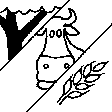
Mixte (cultures/ pâturages/ arbres), incluant l'agroforesterie
- Sylvo-pastoralisme
Principaux produits/ services:
Acacia, Russian willow, mulberry. almond, grass and leaves for fodder
Si l'utilisation des terres a changé en raison de la mise en œuvre de la Technologie, indiquez l'utilisation des terres avant la mise en œuvre de la Technologie:
Some of the forest land has been heavily degraded and was used as grazing land for an extensive period. Most of the land is forest land.
3.3 Informations complémentaires sur l'utilisation des terres
Approvisionnement en eau des terres sur lesquelles est appliquée la Technologie:
- mixte: pluvial-irrigué
Commentaires:
During the first three years the forest requires irrigation due to aridity. The first year of irrigation is supported by the project, and the rest of the irrigation measures are implemented by the local community with the support of the NRMC.
Nombre de période de croissance par an: :
- 1
3.4 Groupe de GDT auquel appartient la Technologie
- Amélioration de la couverture végétale/ du sol
3.5 Diffusion de la Technologie
Spécifiez la diffusion de la Technologie:
- répartie uniformément sur une zone
Si la Technologie est uniformément répartie sur une zone, indiquez la superficie couverte approximative:
- 0,1-1 km2
Commentaires:
23.6 ha
3.6 Mesures de GDT constituant la Technologie

pratiques végétales
- V1: Couverture d’arbres et d’arbustes
- V2: Herbes et plantes herbacées pérennes
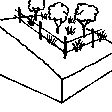
modes de gestion
- M1: Changement du type d’utilisation des terres
3.7 Principaux types de dégradation des terres traités par la Technologie

érosion hydrique des sols
- Wt: perte de la couche superficielle des sols (couche arable)/ érosion de surface
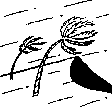
érosion éolienne des sols
- Et: perte de la couche superficielle des sols (couche arable)

dégradation biologique
- Bc: réduction de la couverture végétale
- Bq: baisse de la quantité/ biomasse
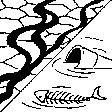
dégradation hydrique
- Ha: aridification
3.8 Prévention, réduction de la dégradation ou réhabilitation des terres dégradées
Spécifiez l'objectif de la Technologie au regard de la dégradation des terres:
- réduire la dégradation des terres
- restaurer/ réhabiliter des terres sévèrement dégradées
4. Spécifications techniques, activités, intrants et coûts de mise en œuvre
4.1 Dessin technique de la Technologie
Auteur:
Aslam Qadamov; Roziya Kirgizbekova
Date:
03/04/2017
4.2 Spécification/ explications techniques du dessin technique
The establishment activities begin with selecting the area for reforestation. Most of the reforestation sites are on slopes above 6% steepness . A plot of 0.2 ha is divided into 4 m x 3 m sections. Planting pits of 50 cm x 30 cm are prepared for planting the trees. Each tree is placed in a pit and good soil is added to the roots. Most popular species used for reforestation are: Russian willow, acacia and mulberry. The newly planted tree is watered and the trunk is covered with a lime and water solution for protection and better growth.
4.3 Informations générales sur le calcul des intrants et des coûts
Spécifiez la manière dont les coûts et les intrants ont été calculés:
- par superficie de la Technologie
Indiquez la taille et l'unité de surface:
1 ha
Indiquez la monnaie utilisée pour le calcul des coûts:
- dollars US
Indiquer le taux de change du dollars en monnaie locale (si pertinent): 1 USD= :
67,0
Indiquez le coût salarial moyen de la main d'œuvre par jour:
5.2-5.3 USD
4.4 Activités de mise en place/ d'établissement
| Activité | Type de mesures | Calendrier | |
|---|---|---|---|
| 1. | Design of the forest plot | Modes de gestion | Winter |
| 2. | Digging pits 50 cmx 30 cm for tree plantation | Structurel | End of winter |
| 3. | Planting tree seedlings 3m x 4m | Végétale | Spring/Rainy season |
| 4. | Watering the tree after planting | Végétale | Spring |
| 5. | Covering the tree with lime | Autres mesures | Spring |
4.5 Coûts et intrants nécessaires à la mise en place
| Spécifiez les intrants | Unité | Quantité | Coûts par unité | Coût total par intrant | % des coût supporté par les exploitants des terres | |
|---|---|---|---|---|---|---|
| Main d'œuvre | Design of the forest | person-day | 15,0 | 5,3 | 79,5 | |
| Main d'œuvre | Digging pits/holes for the trees | person-day | 22,0 | 5,3 | 116,6 | |
| Main d'œuvre | Planting tree seedlings and watering | person-day | 15,0 | 5,3 | 79,5 | |
| Main d'œuvre | Fertilizer and lime application | person-day | 8,0 | 5,3 | 42,4 | |
| Equipements | Meter | piece | 1,0 | 2,25 | 2,25 | |
| Equipements | Shovel | piece | 2,0 | 3,8 | 7,6 | |
| Equipements | Pickaxe | piece | 1,0 | 2,25 | 2,25 | |
| Equipements | Rope | meter | 500,0 | 0,07 | 35,0 | |
| Matériel végétal | Accacia seedlings | piece | 275,0 | 0,45 | 123,75 | |
| Matériel végétal | Russian willow seedlings | piece | 275,0 | 0,45 | 123,75 | |
| Matériel végétal | Mulberry seedlings | piece | 275,0 | 0,45 | 123,75 | |
| Engrais et biocides | DAP | kg | 250,0 | 0,9 | 225,0 | |
| Engrais et biocides | Lime | kg | 25,0 | 1,5 | 37,5 | |
| Coût total de mise en place de la Technologie | 998,85 | |||||
Si le coût n'est pas pris en charge à 100% par l'exploitant des terres, indiquez qui a financé le coût restant:
Livelihood Improvement Project Takhar (LIPT) implemented by Terre des hommes (Tdh) Switzerland
Commentaires:
Costs calculated for a Technology area of 1ha was only done for the purpose of the WOCAT documentation. In reality SLM plots are on average 0.4 ha or 2 jiribs. Costs were simply multiplied by 2.5. The actual costs for a 1ha plot might be slightly different.
4.6 Activités d'entretien/ récurrentes
| Activité | Type de mesures | Calendrier/ fréquence | |
|---|---|---|---|
| 1. | Protecting the trees from livestock | Modes de gestion | Spring/Summer |
| 2. | Pest and disease control | Végétale | Spring |
| 3. | Irrigation | Agronomique | Summer/First three years |
| 4. | Replanting dead trees | Végétale | Spring |
| 5. | Pruning | Agronomique | Spring |
4.7 Coûts et intrants nécessaires aux activités d'entretien/ récurrentes (par an)
| Spécifiez les intrants | Unité | Quantité | Coûts par unité | Coût total par intrant | % des coût supporté par les exploitants des terres | |
|---|---|---|---|---|---|---|
| Main d'œuvre | Pest and disease control | person day | 7,5 | 5,3 | 39,75 | 100,0 |
| Main d'œuvre | Replanting dead trees | person day | 7,5 | 5,3 | 39,75 | 100,0 |
| Main d'œuvre | Irrigating the trees | person day | 10,0 | 5,3 | 53,0 | 100,0 |
| Main d'œuvre | Pruning | person day | 5,0 | 5,3 | 26,5 | 100,0 |
| Coût total d'entretien de la Technologie | 159,0 | |||||
Commentaires:
Costs calculated for a Technology area of 1ha was only done for the purpose of the WOCAT documentation. In reality SLM plots are on average 0.4 ha or 2 jiribs. Costs were simply multiplied by 2.5. The actual costs for a 1ha plot might be slightly different.
4.8 Facteurs les plus importants affectant les coûts
Décrivez les facteurs les plus importants affectant les coûts :
Due to the remoteness of the villages where the technology has been implemented, all the inputs for establishment, such as agricultural equipment, plant material, fertilizers, etc., are purchased in Rustaq town. The expenses for traveling and delivering the inputs affect the establishment costs.
5. Environnement naturel et humain
5.1 Climat
Précipitations annuelles
- < 250 mm
- 251-500 mm
- 501-750 mm
- 751-1000 mm
- 1001-1500 mm
- 1501-2000 mm
- 2001-3000 mm
- 3001-4000 mm
- > 4000 mm
Spécifiez la pluviométrie moyenne annuelle (si connue), en mm:
564,00
Spécifications/ commentaires sur les précipitations:
Average annual precipitation for the area was calculated with 564 mm, with minimum in dry years (2000 and 2001) of 270 mm and maximum in wet years (2009/2010) of 830 mm. The absolute maximum rainfall was calculated for 1986 with 1024 mm. The data series covers the time from 1979 to 2014.
Indiquez le nom de la station météorologique de référence considérée:
Climate Forecast System Reanalysis (CFSR), http://rda.ucar.edu/pub/cfsr.html
Zone agro-climatique
- semi-aride
Derived from the publicly available dataset on length of growing period (LGP) (Fischer 2009 / IIASA-FAO). Internet link: http://tiles.arcgis.com/tiles/P8Cok4qAP1sTVE59/arcgis/rest/services/Length_of_growing_period/MapServer
5.2 Topographie
Pentes moyennes:
- plat (0-2 %)
- faible (3-5%)
- modéré (6-10%)
- onduleux (11-15%)
- vallonné (16-30%)
- raide (31-60%)
- très raide (>60%)
Reliefs:
- plateaux/ plaines
- crêtes
- flancs/ pentes de montagne
- flancs/ pentes de colline
- piémonts/ glacis (bas de pente)
- fonds de vallée/bas-fonds
Zones altitudinales:
- 0-100 m
- 101-500 m
- 501-1000 m
- 1001-1500 m
- 1501-2000 m
- 2001-2500 m
- 2501-3000 m
- 3001-4000 m
- > 4000 m
5.3 Sols
Profondeur moyenne du sol:
- très superficiel (0-20 cm)
- superficiel (21-50 cm)
- modérément profond (51-80 cm)
- profond (81-120 cm)
- très profond (>120 cm)
Texture du sol (de la couche arable):
- moyen (limoneux)
Texture du sol (> 20 cm sous la surface):
- moyen (limoneux)
Matière organique de la couche arable:
- moyen (1-3%)
- faible (<1%)
Si disponible, joignez une description complète du sol ou précisez les informations disponibles, par ex., type de sol, pH/ acidité du sol, capacité d'échange cationique, azote, salinité, etc.
Local land users refer to the soil type where reforestation is implemented as:
Dark soil is characterized as: moderately deep; topsoil texture medium, below surface texture medium; and medium topsoil organic matter.
Light soil is characterized as: moderately deep; texture medium; medium, low organic matter.
5.4 Disponibilité et qualité de l'eau
Profondeur estimée de l’eau dans le sol:
5-50 m
Disponibilité de l’eau de surface:
moyenne
Qualité de l’eau (non traitée):
eau potable
La salinité de l'eau est-elle un problème? :
Non
La zone est-elle inondée?
Oui
Régularité:
épisodiquement
Commentaires et précisions supplémentaires sur la qualité et la quantité d'eau:
Floods occur mainly during the rainy seasons in spring and autumn. Availability of surface water varies in the three study villages. Sari Joy and Dashti Mirzai have good surface water availability, which is also food for drinking. Jawaz Khana has poor water both in quality and availability. Water has to be fetched from a distant stream.
5.5 Biodiversité
Diversité des espèces:
- faible
Diversité des habitats:
- faible
5.6 Caractéristiques des exploitants des terres appliquant la Technologie
Sédentaire ou nomade:
- Sédentaire
Orientation du système de production:
- subsistance (auto-approvisionnement)
- mixte (de subsistance/ commercial)
Revenus hors exploitation:
- 10-50% de tous les revenus
- > 50% de tous les revenus
Niveau relatif de richesse:
- moyen
- riche
Individus ou groupes:
- individu/ ménage
- groupe/ communauté
Niveau de mécanisation:
- travail manuel
Genre:
- femmes
- hommes
Age des exploitants des terres:
- personnes d'âge moyen
- personnes âgées
Indiquez toute autre caractéristique pertinente des exploitants des terres:
The land users in the area where the Technology is applied belong to the Uzbek ethnic minority group Qarluq. Although the men are generally the main land users, women and children also take active part in the related work. The functions of men and women are clearly distinguished within the Afghan society. At the same time within the family this division of work and functions also results in men and women working hand-in-hand. An improvement of the family’s livelihood situation is expected to positively affect all family members. While it is recognized that the involvement of women is key in order to secure basic human rights for everyone, to achieve good governance, sustainable development, and to efficiently contribute to poverty reduction (SDC 2004), it is also clear that a context sensitive approach is of high importance.
Women in rural Afghanistan are involved in many production and income generating activities that contribute to the overall household income, however very few women own resources such as land and livestock, and their income generating options are fewer in comparison to that of men.
5.7 Superficie moyenne des terres détenues ou louées par les exploitants appliquant la Technologie
- < 0,5 ha
- 0,5-1 ha
- 1-2 ha
- 2-5 ha
- 5-15 ha
- 15-50 ha
- 50-100 ha
- 100-500 ha
- 500-1 000 ha
- 1 000-10 000 ha
- > 10 000 ha
Cette superficie est-elle considérée comme de petite, moyenne ou grande dimension (en se référant au contexte local)?
- moyenne dimension
5.8 Propriété foncière, droits d’utilisation des terres et de l'eau
Propriété foncière:
- communauté/ village
- individu, sans titre de propriété
Droits d’utilisation des terres:
- communautaire (organisé)
- individuel
Droits d’utilisation de l’eau:
- communautaire (organisé)
Commentaires:
Those who own land and use water for irrigation are obliged to pay for water. The payment is made either in kind or in cash to Mirob - the person in charge of distributing water in the community. The amount of the payment varies from village to village.
6. Impacts et conclusions
6.1 Impacts sur site que la Technologie a montrés
Impacts socio-économiques
Production
production fourragère
production animale
production de bois
production forestière non ligneuse
diversité des produits
Impacts socioculturels
connaissances sur la GDT/ dégradation des terres
Commentaires/ spécifiez:
Land users learned new methods of planting trees based on the local conditions.
situation des groupes socialement et économiquement désavantagés
Commentaires/ spécifiez:
The established forest is expected to become a reliable source for firewood, which will decrease the burden of women and children under 15 years, who spend long hours to collect firewood.
Impacts écologiques
Cycle de l'eau/ ruissellement
ruissellement de surface
Sols
perte en sol
Biodiversité: végétale, animale
Couverture végétale
6.2 Impacts hors site que la Technologie a montrés
inondations en aval
envasement en aval
capacité tampon/de filtration
Commentaires concernant l'évaluation des impacts:
Based on the Land User Protocols: Individual SLM implementers were asked to rate the benefits for their Technology. They were asked to indicate production increase of crops; fodder; animals; wood; non-wood forest products; increase in product diversity; or production area. The most important increase they rated with 3, the second most with 2, others with 1 point. Averages of the points given by all SLM implementers are reflected here.
Based on the Land User Protocols: Individual SLM implementers were asked to rate the on-site and off-site impacts of the Technology on water; soil; and vegetation. They were asked to indicate the strength of impacts with three, two or one points. Averages of the points given by all implementers are reflected here.
6.3 Exposition et sensibilité de la Technologie aux changements progressifs et aux évènements extrêmes/catastrophes liés au climat (telles que perçues par les exploitants des terres)
Extrêmes climatiques (catastrophes)
Catastrophes météorologiques
| Comment la Technologie fait-elle face à cela? | |
|---|---|
| pluie torrentielle locale | très bien |
Catastrophes climatiques
| Comment la Technologie fait-elle face à cela? | |
|---|---|
| sécheresse | bien |
Commentaires:
Based on the multi-criteria matrix: SLM implementers were asked to jointly discuss and rate how much the SLM technology reduced the lands vulnerability to drought and local rainstorms. Only vulnerability to the most prevalent climate extremes (drought and local rainstorms) was discussed. SLM technologies were rated as reducing vulnerability poorly, well, or very well. The average points reflected here are from multi-criteria matrixes compiled in three villages where the SLM technology had been implemented
6.4 Analyse coûts-bénéfices
Quels sont les bénéfices comparativement aux coûts de mise en place (du point de vue des exploitants des terres)?
Rentabilité à court terme:
très positive
Rentabilité à long terme:
très positive
Commentaires:
Based on the multi-criteria matrix: During the FGD with SLM implementers, a multi-criteria matrix was elaborated, and different SLM practices were rated. In the framework of this exercise, SLM implementers were asked to jointly discuss and rate short term (1-3 years) and long-term (10 years) returns. As the SLM technology was only implemented 1-2 years ago, it is too early to compare benefits to maintenance costs. Farmers have little experience so far on the actual benefits of the SLM technology. The ratings are mostly based on expected benefits and not on actual benefits.
6.5 Adoption de la Technologie
- 1-10%
Si disponible, quantifiez (nombre de ménages et/ou superficie couverte):
23.6 ha have been afforested with LIPT support
Parmi tous ceux qui ont adopté la Technologie, combien d'entre eux l'ont fait spontanément, à savoir sans recevoir aucune incitation matérielle ou aucun paiement?
- 10-50%
Commentaires:
Based on the Land User Protocol: Individual SLM implementers were asked whether they received support for implementing the Technology. Each indicated the type of support he received from the proposed options: "Full Support 100%, Some Support, No Support 0%".
6.6 Adaptation
La Technologie a-t-elle été récemment modifiée pour s'adapter à l'évolution des conditions?
Non
6.7 Points forts/ avantages/ possibilités de la Technologie
| Points forts/ avantages/ possibilités du point de vue de l'exploitant des terres |
|---|
| The tree plantations protect the soil from erosion. The land is less vulnerable to heavy rainfall, which washes off the topsoil |
| There are very high expectations about production of firewood. Availability of firewood in local forest will make it much easier to access firewood for cooking and heating by local households. |
| Apart from firewood and wood production, other non-timber products are provided by the afforestation plots, such as fodder for livestock from grass (alfalfa, sainfoin) and tree leaves during autumn. Also some plots are planted with almond and mulberry, which can be collected for own use or for selling. |
| Local people value the recreational benefit of the forest, which make their villages greener and provide green spaces for the local people. |
| Points forts/ avantages/ possibilités du point de vue du compilateur ou d'une autre personne ressource clé |
|---|
| The afforestation measures in the village including establishing the forest and protecting it, mobilizing the community around a common goal, and this has a positive impact on the village as a whole. |
| The planted trees and grass under the trees improve the vegetation cover and increase soil quality, which is then less prone to erosion |
| Improved varieties of fruit and non-fruit tree species used for afforestation help to diversify the tree species in the village and make the soil less resistant to dry spells |
| The expected combined benefits of wood and non-wood products, especially when the harvesting period starts, may have positive impact on households' income and food security. |
6.8 Faiblesses/ inconvénients/ risques de la Technologie et moyens de les surmonter
| Faiblesses/ inconvénients/ risques du point de vue de l’exploitant des terres | Comment peuvent-ils être surmontés? |
|---|---|
| The establishment costs for afforestation measures are very high | |
| The young trees are vulnerability to droughts | |
| During maintenance some plots require irrigation | |
| Afforestation plots, which are established on former grazing land, reduces the grazing land in the village and deprives animals from grazing land |
| Faiblesses/ inconvénients/ risques du point de vue du compilateur ou d'une autre personne ressource clé | Comment peuvent-ils être surmontés? |
|---|---|
| Community provides weak or no protection of the afforestation site, which results in low tree survival | |
| Weak funding sources for irrigation of the afforestation plots, particularly during the first three years when the trees are young, might compromise the new plantations | |
| Afforestation is established mostly on community land, where unclear land tenure rights persist, which may cause conflict in the community over forest vs grazing land |
7. Références et liens
7.1 Méthodes/ sources d'information
- visites de terrain, enquêtes sur le terrain
No field visits were conducted
- interviews/entretiens avec les exploitants des terres
Focus group discussions (FGD) were organized by the CDE team to collect information from SLM implementers. Total of 15 land users who have implemented afforestation, participated in the FGDs held in the three villages of Sari Joy, Jawaz Khana and Dashti Mirzai.
Interviews were conducted by the HAFL team to collect information from persons representing all the three study villages. Very detailed interviews were conducted with 30 persons interested in afforestation implementation, of which 20 persons are from households that already have implemented afforestation.
- interviews/ entretiens avec les spécialistes/ experts de GDT
Close collaboration took place during the compilation of this material with the technical staff of the LIPT project in Rustaq.
- compilation à partir de rapports et d'autres documents existants
Information provided in the reports of the LIPT project in Rustaq served as an initial source of information during the preparatory phase and also solidifying the description of the technology and area of implementation. Other background papers on Afghanistan were referred to for general information on agriculture and natural resource management in Afghanistan.
7.2 Références des publications disponibles
Titre, auteur, année, ISBN:
Guidelines for Focus Groups Discussions
Titre, auteur, année, ISBN:
Methods section of the Rustaq NRM study
Liens et modules
Développer tout Réduire toutLiens
Aucun lien
Modules
Aucun module trouvé


